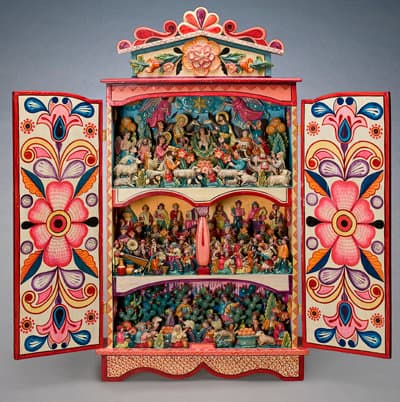Peruvian Retablos / Portable Boxes with Scenes
Appropriate for grades: K - 12
Subject areas: History and Social Studies Mathematics Visual and Performing Arts
The Europeans reached the Andes in 1526, and by the 1530s they had conquered most of the ethnic groups living throughout the vast territory. They introduced many aspects of their own culture, including the Spanish language and Roman Catholic religion. They also brought new food crops and domesticated animals, along with European forms of art, craft, and clothing. The European practice of using small, box like altars to carry sacred images was introduced into the Andes by Spanish priests and European colonists in the sixteenth century. Catholic missionaries utilized the small shrines to facilitate religious teaching in the Indian villages. By the eighteenth century, Andean devotion to Catholic images had increased and portable altars were used to keep Christian figures in homes as well as to carry them to local churches to receive blessings from the priests. By the nineteenth century the indigenous people were freer to use the traveling shrines for their own types of religious practices. Spanish Language Version
Teaching / Learning Goals:
Teachers and students will …
Objectives
-
Understand the way that Peruvian retablos are used in devotional practices or as illustrations of everyday life (historical and cultural understanding).
-
Describe and discuss the process of making a retablo, including the use of symbols and imagery, their meaning and the materials that are used (perceiving, analyzing and responding).
-
Explore 2 and/or 3 dimensional design elements shapes and forms, decorative motifs, materials and symbols when making their own retablo (creating and performing).
